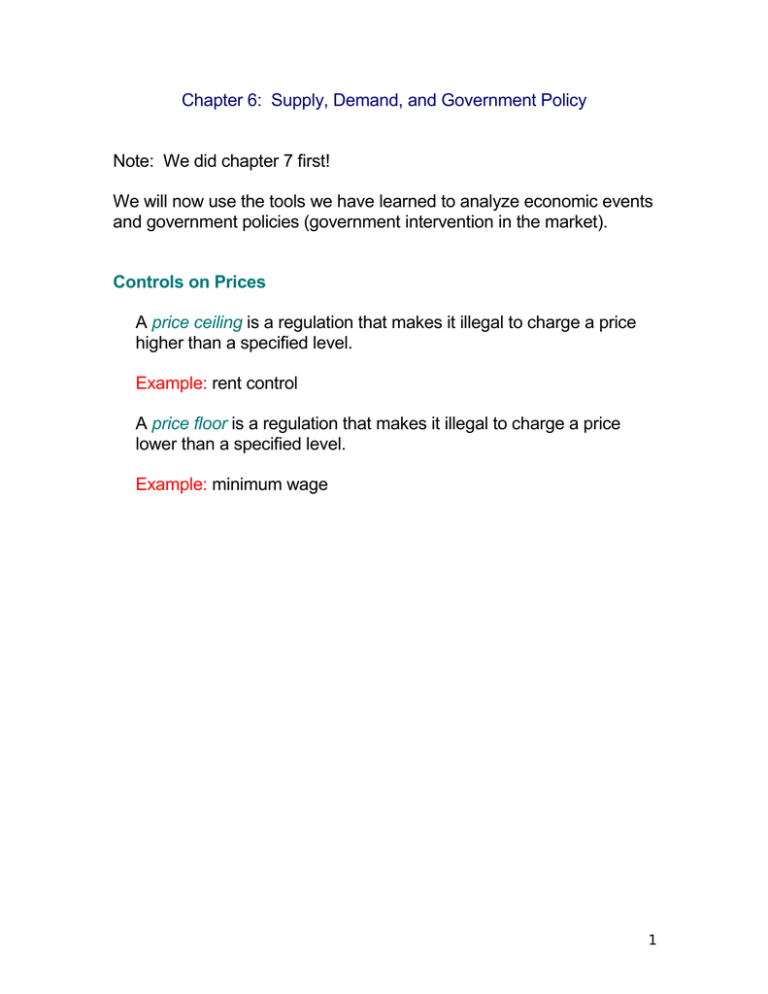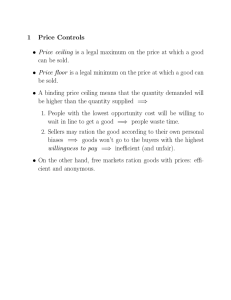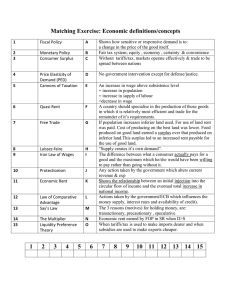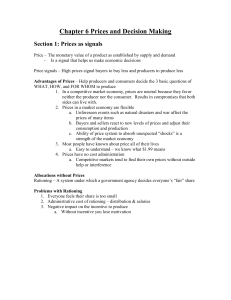Chapter 6: Supply, Demand, and Government Policy
advertisement

Chapter 6: Supply, Demand, and Government Policy Note: We did chapter 7 first! We will now use the tools we have learned to analyze economic events and government policies (government intervention in the market). Controls on Prices A price ceiling is a regulation that makes it illegal to charge a price higher than a specified level. Example: rent control A price floor is a regulation that makes it illegal to charge a price lower than a specified level. Example: minimum wage 1 RENT CONTROL 1. There is a shortage in the market 2. Unlike in previous example, market forces are not allowed to function since the price is fixed. 3. The shortage will be persistent! Problem: Price can’t equilibrate the market! Result: • A lot of search (think about trying to rent a place in NYC) • Black markets ⇒side payments ⇒bribes Question: Does this policy ensure that the poorest people get the product? Answer: No, not necessarily. Who gets the apartments? • Those able to bribe or make side payments • Those with good luck Question: Is society better off with this policy? Answer: 2 No, there is a deadweight loss. Notes: • At Q* there is maximum surplus. • With the price ceiling, surplus is not maximized. • Surplus has been lost due to underproduction Question: Who is better off with rent control? Winners: • Demanders who can buy the product (those who get apartments). They gain consumer surplus. Losers: • All suppliers. They lose producer surplus. • Demanders who can not buy the product (those who do not get apartments). They lose consumer surplus. The losses of the losers are greater than the gains of the winners! We end up with a deadweight loss. Definition: Deadweight loss is the fall in the total surplus that restuls from a market distortion. 3 Discussion Policymakers often react to the effects of rent control by imposing additional regulations. • laws that make racial discrimination in housing illegal • laws that require landlords to provide minimally adequate living conditions. These laws are • difficult and costly to enforce. • less necessary when the market for housing is regulated by the forces of competition (In a free market, the price of housing adjusts to eliminate the shortages that give rise to undesirable landlord behavior.) Markets are usually a good way to organize economic activity!!! • When prices are set by law, they obscure the signals that normally guide the allocation of society’s resources. Policymakers are led to control prices because they view the market’s outcome as unfair. • Price controls are often aimed at helping the poor. • Yet, price controls often hurt those they are trying to help. Benefit: Cost: May keep rents low, Discourages landlords from maintaining their building Makes housing hard to find. We need other policies. • Of course, alternative policies may also not be perfect. • But they may dominate rent control. 4 MINIMUM WAGE Supply curve = supply of labor (set by employees) Demand curve = demand for labor (set by employers) Result of minimum wage: • A persistent surplus of labor. • A deadweight loss. Who benefits? • Suppliers who can sell at the higher price (those who get hired). Gain producer surplus. Who loses? • All demanders (must pay higher price). Lose consumer surplus. • Suppliers who can not sell at higher price (those unemployed). Lose producer surplus. Net result • Society worse off. • A deadweight loss. 5 Discussion Minimum wage has its greatest impact on the market for teenage labor. Although debatable many economists that have studied how minimum wage laws affect the teenage market have found that it depresses employment. Advocates view the policy as a way to raise the income of the working poor. They say: • Even though it has some adverse effects (unemployment), the effects are small and the higher minimum wage makes poor better off. Opponents say it is not the best way to combat poverty. They say: • Higher minimum wage causes unemployment • Prevents some unskilled workers from getting on the job training they need • Encourages kids to drop out of school • Not targeted to families --- fewer than a third of minimum wage earners are in families with income below the poverty line. Alternative policy ---- earned income tax credit ---- a government program that supplements the incomes of low-wage workers. 6 TAXES National Organization of Ice Cream Makers argues tax should be imposed on buyers. American Association of Ice Cream Eaters argues tax should be imposed on sellers. Mayor, hoping to reach a compromise, suggests half be paid by buyers and half by sellers! When the government imposes a tax on a good, who bears the burden of the tax? The people buying the good? The people selling the good? What determines who bears the burden? 7 Tax incidence Tax incidence is the study of who bears the burden of taxation. Start with a tax on buyers. How do taxes on buyers affect market outcomes? Analysis 1. Which curve shifts? Initial impact is on D for ice cream. 2. Which way does the curve shift? D curve shifts to the left. 3. What is new equilibrium price and quantity? At new equilibrium, quantity is lower and price is higher. IMPORTANT • Price does not go up by full amount of tax!!! • Buyers pay higher price and are worse off, BUT, • Sellers receive less than before the equilibrium. • The burden is shared. 8 Tax on sellers How do taxes on sellers affect market outcomes? 1. Initial impact is on the supply of ice cream. 2. Shifts S to left 3. New equilibrium is the same as when tax was on buyers! Burden shared. 9 Lessons on Tax Incidence 1. Taxes on buyers and taxes on sellers are equivalent. The tax places a WEDGE between the price paid by the buyer and received by the seller. The wedge is the same no matter if the tax is imposed on buyers or sellers. 2. Unless demand or supply curves are perfectly elastic or inelastic, the tax burden will be shared by buyers and sellers. 3. Elasticity matters. a. The more elastic is demand the more able the demander is to avoid the tax and the smaller (larger) is the burden on the demander (supplier). When D is elastic ⇒ there are a lot of good substitutes ⇒ lots of options ⇒if suppliers increase price then you shift away ⇒ supplier eats the tax. Example: Tax on cheese pizza When D is inelastic ⇒ there are not a lot of good substitutes ⇒ lots of options ⇒ if suppliers increase price then you are not able to shift away ⇒ you (demanders) eat the tax Example: Tax on yachts b. The more elastic is supply the more able the supplier is to avoid the tax and the smaller (larger) is the burden on the supplier (demander). 10 c. The same intuition carries over to supply 4. Supply inelastic ⇒ suppliers bear a lot of the burden demanders bear little of the burden Supply elastic ⇒ suppliers bear little of the burden demanders bear a lot of the burden Deadweight loss of taxation (chapter 8) 11









